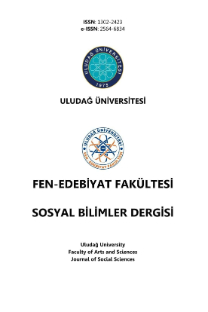VAN DEPREMİ SONRASI DUYGUSAL, BİLİŞSEL VE DAVRANIŞSAL TEPKİLER: POLİS ÖRNEKLEMİ İNCELEMESİ
Emotional, Cognitive and Behavioral Reactions After Van Earthquake: Examination of Police Sample
___
- Abdollahi, M. K. (2002). Understanding police stress research. Journal of Forensic Psychology Practice, 2(2), 1-24.
- Caia G., Ventimiglia F. ve Maass A. (2010). Container vs. dacha: The psychological effects of temporary housing characteristics on earthquake survivors. Journal of Environmental Psychology 30, 60– 66
- Darensburg, T., Andrew, M. E., Hartley, T. A., Burchfiel, C. M., Fekedulegn, D. ve Violanti J. M. (2006) Gender and Age Differences in Posttraumatic Stress Disorder and Depression Among Buffalo Police Officers. Traumatology, 12 (3), 220-228.
- Efe, R. ve Demirci, A. (2001). Gölcük 1999 Depreminde Zemin ve Yer şekil Özelliklerinin Şiddet ile Hasar Dağılışına Etkisi. Türk Coğrafya Dergisi, 36, 1-15.
- EM-DAT, (2009). The OFDA/CRED International Disaster Database. Universite´ catholique de Louvain—Brussels—Belgium. Available www.emdat.be. Accessed 26 August 2009.
- Karancı, A. N. (2011). Tabanlı-Van (23 Ekim 2011) ve Edremit-Van (9 Kasım 2011) Depremleri İnceleme Raporu 25-27 Kasım 2011, Ankara, Orta Doğu Teknik Üniversitesi Afet Yönetimi Uygulama ve Araştırma Merkezi.
- Kasapoğlu A. ve Ecevit M. (2003). Impact of the 1999 East Marmara Earthquake in Turkey. Population and Environment, 24(4), 339-358.
- Knack J. M., Chen Z., Williams K. D., ve Jensen-Campbell L. A. (2006). Opportunities and Challenges for Studying Disaster Survivors. Analyses of Social Issues and Public Policy, 6(1), 175-189.
- Neisser, U., ve Harsch, N. (1992). Phantom flashbulbs: False recollections of hearing the news about Challenger. In E. Winograd & U. Neisser (Eds.), Affect and accuracy in recall: Studies of “flashbulb” memories (p.9-31). New York: Cambridge University Press.
- Neisser, U., Winograd, E., Bergman, E. T., Schreiber, C. A., Palmer, S. E. ve Weldon M. S. (1996). Remembering the Earthquake: Direct Experience vs. Hearing the News. Memory, 4 (4), 337-357
- McClure J., Sutton R. M. ve Wilson M. (2007). How information about building design influences causal attributions for earthquake damage. Asian Journal of Social Psychology, 10, 233–242.
- Prati G., Catufi V. ve Pietrantoni L. (2012). Emotional and behavioural reactions to tremors of the Umbria–Marche earthquake. Disasters, 36(3): 439−451.
- Prati G. ve Pietrantoni L. (2009). Optimism, Social Support, and Coping Strategies As Factors Contributing to Posttraumatic Growth: A Meta-Analysis. Journal of Loss and Trauma: International Perspectives on Stress & Coping, 14(5), 364-388.
- Sarp N. ve Tosun A. (2011). Duygu ve Otobiyografik Bellek. Psikiyatride Güncel Yaklaşımlar, 3(3),446-465.
- Solak N. ve Göregenli M. (2009).Yoksulluğa İlişkin Nedensel Atıflar Ölçeği’nin Geliştirilmesi ve Psikometrik Özelliklerinin Değerlendirilmesi. Türk Psikoloji Yazıları, 12 (24), 72-89.
- Şahin, C. ve Sipahioğlu, Ş. (2003). Doğal Afetler ve Türkiye, 2.bs, Ankara: Gündüz Eğitim ve Yayıncılık.
- Tierney, K. J. (1989). The social and community contexts of disaster. In R.Gist & Lubin (Ed). Psychosocial aspects of disaster. (p.11-39). New York: JohnWiley & Sons.
- Tuna, K., Parin, S. ve Tanhan, F. (2012). Van Depremi Sosyo-Ekonomik ve Psikolojik Durum Tesbiti Araştırması Sosyolojik Gözlem Raporu. Çocuk Vakfı Raporları: 15, İstanbul: Çocuk Vakfı Yayınları.
- Uyar, S. (2007), Afet ve Psikiyatrik Bozukluklar, Mehmet Eryılmaz ve Ufuk Dizer (Editörler), Afet Tıbbı, (s. 937-947), Ankara: Ünsal Yayınları.
- Xiong K., Chaojie L. ve Ningxiu L. (2010). Social support and Quality of Life: a cross-sectional study on survivors eight months after the 2008 Wenchuan earthquake. BMC Public Health, 10, 573-584.
- Violanti, J. M., Andrew, M., Burchfiel, C. M., Hartley, T. A., Charles, L. E.,
- ve Miller, D. B. (2007). Post-traumatic stress symptoms and cortisol patterns among police officers. Policing: An International Journal of Police Strategies & Management, 30(2), 189-202.
- ISSN: 1302-2423
- Yayın Aralığı: 2
- Başlangıç: 1999
- Yayıncı: Bursa Uludağ Üniversitesi
KÜLTÜR VARLIĞI ALGISI VE TAHRİBAT Bursa Yenişehir Örneği Üzerinden Bir Değerlendirme
TÜRK KAMU YÖNETİMİNDE YETKİ DEVRİ
R. Cengiz DERDİMAN, YUSUF UYSAL
ALAN DİLİ SÖZ VARLIĞININ GENEL DİLDEKİ İLİŞKİLERİ ÜZERİNE: SPOR TERİMLERİ ÖRNEĞİ
HAKİMİYET-İ MİLLİYE SAYFALARINDAN İŞGAL ALTINDAKİ ANTEP
ESKİ ROMA AİLESİNDE “PATER FAMILIAS” ve “PATRIA POTESTAS” KAVRAMLARI
KAMİL DOĞANCI, Fulya KOCAKUŞAK
DİVAN ŞİİRİNE BURSA’DAN ELEŞTİREL BİR SES: MEHMED RIF’AT EFENDİ
VAN DEPREMİ SONRASI DUYGUSAL, BİLİŞSEL VE DAVRANIŞSAL TEPKİLER: POLİS ÖRNEKLEMİ İNCELEMESİ
